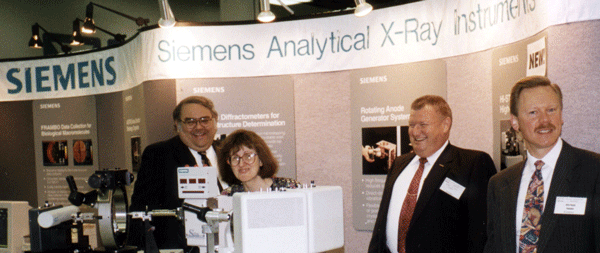"ACA 50th Anniversary: Presidential memoirs, Exhibitor memoirs, Nostalgia
ACA Past Presidents gathered at McMaster University in 1986. Back row: Dave Sayre, Bob Newnham, Dave Shoemaker, and Ken Trueblood. Center row: Ray Young, Jerome Karle, Phil Coppens, Bill Busing, Bill Duax, and John Kasper. Front row: Isabella Karle, Sidney Abrahams, David Harker and Hal Wyckoff.
Elizabeth Wood, David Templeton, Robinson Burbank, Sidney Abrahams with the ACA 50th birthday cake at the 2000 ACA Annual meeting in St. Louis, MO.
Presidential Memoirs
 Rob Burbank's excellent letter covers much that I had remembered. He and I met at a meeting of the American Society for X-ray and Electron Diffraction in 1948 and have kept in touch ever since. That society was so small that the members all knew each other. We met at such places as Gibson Island and a small hotel on Lake George and enjoyed outdoor recreation together. Rob Burbank's excellent letter covers much that I had remembered. He and I met at a meeting of the American Society for X-ray and Electron Diffraction in 1948 and have kept in touch ever since. That society was so small that the members all knew each other. We met at such places as Gibson Island and a small hotel on Lake George and enjoyed outdoor recreation together.
When it became apparent that ASXRED and the Crystallographic Society of America were covering much the same ground at their meetings a decision was made to join in a single society. The name American Crystallographic Society was favored by many, but the initials ACS already meant American Chemical Society to most. Bert Warren said that he was a physicist and wanted to keep the name ASXRED with reference to crystals.
When the name American Crystallographic Association was finally chosen Lindo Patterson and I drew up the constitution and by-laws. Contrary to the ruling in many societies, we required two nominations for each office.
In 1956 Jose Donnay who had been Vice-President the previous year became President and I was elected Vice-President, succeeding to the office of President in 1957, being the first woman to hold that office. In that same year I was Chairman of the USA delegation to the International Union of crystallography. This involved a meeting at the State Department in which I shocked them by saying that our delegation would not take instructions as to how to vote concerning the admission of delegates to the IUCr from countries currently out of favor with our State Department.
That was a busy and interesting year for me and I still appreciate the support given me by Bell Laboratories, now included in Lucent Technologies.
John S. Kasper (ACA President - 1967) / Charlys Lucht Kasper
 John and I wish to thank you for your invitation for him to attend the 50th Anniversary Meeting of the ACA in St. Paul. We regret it is not possible for us to attend. John has been legally blind for many years and suffered a stroke 3 years ago that left him able to walk around, but his mind was not so lucky. His memory is very poor and he has trouble finding words to communicate. He knows he was once president of ACA but his memory of that year (1967) is gone. He does not have the strength to travel. The end of March he had a second melanoma removed from his eye and is still recovering from that surgery. John and I wish to thank you for your invitation for him to attend the 50th Anniversary Meeting of the ACA in St. Paul. We regret it is not possible for us to attend. John has been legally blind for many years and suffered a stroke 3 years ago that left him able to walk around, but his mind was not so lucky. His memory is very poor and he has trouble finding words to communicate. He knows he was once president of ACA but his memory of that year (1967) is gone. He does not have the strength to travel. The end of March he had a second melanoma removed from his eye and is still recovering from that surgery.
50 years! I joined the ASXRED while a graduate student with Lawrence Brockway when the meeting was held in Ann Arbor in 1943. David Harker attended that meeting and I was offered a good research job at the GE Research Laboratory, but they would not hire a woman Ph.D. Brockway encouraged me to take the job and finish working for my Ph.D. after the war. I went to work at GE in February 1944. David Harker was John's Ph.D. (1941) advisor at Johns Hopkins University. When the war was over, he asked John to join his crystallography group at GE.
When the structure of decaborane project began, I worked with the two of them, at first to help with the endless calculations with Beevers and Lipson strips and a Marchant calculator. We soon discovered those calculations could be done with punched cards on the new Research Lab computer. However, using every possible technique then available for locating a few atoms in the structure, we were always stymied by the phase problem. Until the Monday morning when John asked me to see that he could work uninterrupted getting down on paper the ideas he had mulled over all weekend for using Cauchy Inequalities. He thought there was some relationship that could let us fix a few signs (+ or -) and perhaps start to unravel the structure. Dave Harker came in a while later and there was great excitement when he saw that John had indeed discovered a possible way out of our impasse. The rest is history. John presented the paper at the Ste. Marguerite meeting of the ASXRED (by Harker, Kasper and Lucht). The third name was mine. GE was changing the management of the Research Laboratory and they didn't really appreciate what John and Dave had done to solve the phase problem. No time to pursue and refine the math of the phase problem. Jerry Karle was definitely interested and came to visit at GE to go over all the details. Then he and Herb Hauptman went on to develop the direct methods which won them the Nobel Prize.
Dave Harker left GE to work on solving a protein structure at Brooklyn Poly. All of us became charter members of ACA. In 1951 the 2nd IUCr was to be held in Stockholm in June. GE approved John's trip to Stockholm and to visit crystallography labs all over Europe as they were recovering from World War II. John and I decided to get married in March so that we could make the trip together. However, GE would not let me continue working at the laboratory as John's wife - so that was the end of my scientific career and the beginning of a long, happy marriage started off with that incredible 6 week tour of European Labs as a slightly delayed honeymoon. I happily entertained all visiting crystallographers who came to GE in subsequent years and attended many ACA and IUCr meetings. Our whole family (3 children) remembers the 1964 meeting at Bozeman. There were 400 accompanying family members at that meeting. The older children helped look after the younger ones. Everyone stayed in the dormitories and wore meal tickets to eat at the college cafeteria. Many long lasting friendships began among the parents as we juggled scientific sessions and kids. The February ACA meetings became my annual vacation when we hired a housekeeper to care for the children, and we went to Seattle, Tucson, New Orleans, Atlanta, Charlottesville and Hawaii. The 1977 meeting at Asilomar we took our 16 year old younger son. Bob played golf most of the time, but has never forgotten Brockway claiming him as a scientific grandson, and Pauling (the Banquet speaker) shook his hand and said that made him his great grandson. Bob is now a college professor and still takes his Vitamin C! And he said it really made him appreciate his studies of Chemistry and Physics to have met over the years so many of the men and women he was reading about. When John was president of ACA, I sat next to Sir Lawrence Bragg at dinner. We had met on several previous occasions in Europe. We both attended the Buffalo meeting of the ACA Sid Abrahams wrote about in his letter. In 1969 most of the arrangements for the IUCr VIII meeting at Stony Brook had to be made by John since David Shoemaker was in Europe. The caterer at the clam bake on Fire Island insisted that in order to be sure he collected every ticket, all 2000 people should wait in line single file to get their traditional bag of food. A sight never to be forgotten. John finally argued him into several parallel lines. Then the French complained that it was barbaric to sit in the blowing sand to eat something as elegant as a lobster!
Sidney Abrahams hoped that the copy of his letter he sent to us would help John's memory - unfortunately it didn't. I have tried to add some of the personal things that happened over the years, and to mention some of the problems that women scientist faced.
Even giant companies have had to change their policies with the times. When John retired in 1980, they hired Dr. Mary Garbauskas to continue the X-ray crystallographic research and she was just one of many women with PhD's working there.
We are certain the that 50th Anniversary Meeting will be a great success and regret that we will not be there to see old friends and appreciate all the scientific progress that has occurred since ACA began.
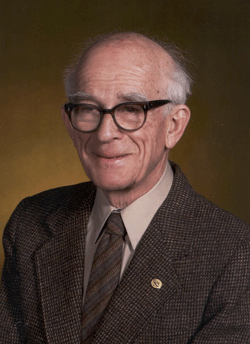 Recollections of the ACA at Penn State, Tucson & Buffalo 1968: Ralph Wyckoff, second president of the ACA, told the Tucson meeting in 1968 that "he was struck by the lack of a sense of history, not only in the outlook of students but in the way science is taught." He went on to say that we should realize we live in a moment of time with important characteristics set by all that has gone before and that we can only perceive the real meaning of our efforts if we appreciate how we come to be making them. The present recollections are not the place for such an overview, beneficial as they might be. Instead they offer brief looks at the 1968 period, when it was my privilege to serve as ACA president, at our first meeting in 1950, and at our most recent meeting in Buffalo as a comparison in miniature. Recollections of the ACA at Penn State, Tucson & Buffalo 1968: Ralph Wyckoff, second president of the ACA, told the Tucson meeting in 1968 that "he was struck by the lack of a sense of history, not only in the outlook of students but in the way science is taught." He went on to say that we should realize we live in a moment of time with important characteristics set by all that has gone before and that we can only perceive the real meaning of our efforts if we appreciate how we come to be making them. The present recollections are not the place for such an overview, beneficial as they might be. Instead they offer brief looks at the 1968 period, when it was my privilege to serve as ACA president, at our first meeting in 1950, and at our most recent meeting in Buffalo as a comparison in miniature.
The ACA had 495 charter members and annual dues of $5.00 in 1950, with Isidor Fankuchen (Fan) as our first President. A total of 120 members participated in our first meeting at Penn State, with ten sessions spread over three days. There were few, if any, accompanying members. The meeting immediately followed a Conference on Computing Methods and the Phase Problem at which David Sayre, later to be 34th ACA president, demonstrated the existence of simple connections between structure factor signs. Ferment in this area had started three years earlier with the discovery by David Harker, 6th president of ASXRED and John Kasper, 18th president of ACA, of structure factor inequality relationships. Ray Pepinsky's analog computer, that instantly let us produce contour maps from a bank of sine wave generators, was also of great interest at this meeting. With amplitudes and phase angles (0 or 180o) set by dials and switches on each generator rack, many trial models could be examined in short order; use of this unprecedented capability brought many of the world's leading crystallographers to Penn State. In addition to a general interest in computers, no doubt related to a distaste for the manual calculations we all performed then on the ubiquitous Marchant or Monroe calculating machine, and in the phase problem, there was considerable activity in developing a range of new techniques.
Among them were methods for extending diffraction measurements to subambient temperatures. Fan had started this approach a year or two earlier with a directed cold air stream that cooled a crystal mounted on a precession camera. I had the opportunity the previous year, on my way to Minneapolis as Bill Lipscomb's (ACA's 6th president) first post doc, of seeing Fan's initial experimental technique. We recognized it as an important advance and were able to improve it, as Fan did also, to become a routine tool from which cryogenic crystallography grew. The majority of the papers at Penn State presented the structures of small organic molecules and simple inorganic materials. All x-ray single crystal diffraction records at that time were registered photographically, and nearly all calculations were made manually. Nevertheless, the meeting had an atmosphere of intellectual excitement and confidence that we would meet the challenges of our field. It was also notable for the generous personal level of interaction among the participants, among whom were such major figures in our field as Lindo Patterson, Bert Warren, Martin Buerger, Paul Ewald and Willie Zachariasen.
The ACA thenceforth met twice yearly until 1984, except for every third year when an IUCr Congress was held. The tradition of scheduling spring meetings in the South and summer meetings in the North made the ACA very accessible to graduate students and faculty around the country. We almost always met on a university campus at no charge. Registration fees were low but paid most of the meeting costs, primarily that of printing and mailing the Abstracts, and most members were willing to use dormitory accommodation. Many lasting personal friendships developed during these meetings.
The spring meeting of my presidency was held February 1968 at Tucson, the summer meeting in August at Buffalo. John Kasper was immediate past president, the ACA having met the previous January at Atlanta and in August at Minneapolis. Walter Hamilton was president when the ACA met March 1969 in Seattle and the Eighth IUCr Congress convened in August at Stony Brook. The accompanying photograph shows these three presidential friends at the Buffalo meeting picnic on Goat Island.
Walter Hamilton (President - 1969),
Sidney Abrahams (President - 1968) and John Kasper (President - 1967)
ACA membership had increased to 1,650 by 1968, the annual dues to $10.00. Tucson attracted 330 participants with 84 papers presented over 14 sessions, while Buffalo drew 480 participants with 150 papers over 20 sessions. Both had registration fees of $8.00. The meeting in summer was always larger than in spring. As was common in those days, ACA Council met all day Sunday before the scientific sessions began, adjourning in time for the traditional evening social to welcome the meeting participants. Among its actions was a proposal for presentation to the Business Meeting later that week by which Council members would automatically become members of the USNCCr, following its earlier reciprocal action. Council also met next evening with the National Committee under chairman David Shoemaker, our 21st ACA president; the deliberations largely concerned local arrangements for the forthcoming IUCr Congress since the National Committee was financially responsible. The writer succeeded David the year following the Congress, thereby inheriting the task of winding up its fiscal obligations. Fortunately, the earlier rather gloomy financial predictions gradually improved and the final balance provided the USNCCr with substantial reserves that allowed it to support young crystallographers in attending future Congresses.
The state of crystallography by the time of the Tucson and Buffalo meetings had advanced strongly since Penn State. Scintillation counters had largely replaced film for recording x-ray diffraction by single crystals, and the automation introduced earlier in the decade had been incorporated into several commercially available automatic diffractometers. A major concern was the accuracy of these instruments, see Volume 1 of the ACA's Transactions for an interesting discussion. Nearly all computations by 1968 were made on mainframe computers or on an increasingly popular series of minicomputers used also to control the diffractometer. Direct methods for solving crystal structures had come into routine use, particularly for organic and biological molecules.
The program in Tucson was rather evenly balanced, with about one-fifth of all papers devoted to organic and biological molecules and the same to inorganic materials; the remainder was distributed about equally between the symposium topic of low energy electron diffraction and thermal motion, the physics of solids and surfaces, apparatus, and diffraction theory.
In a change that foreshadowed a continuing trend over the subsequent decades, more than one-third of all papers presented at the 1968 Buffalo meeting were concerned with biological structure, about one-quarter with organic and organometallic structures, one-fifth with inorganic and mineral structures and the remainder distributed among small angle scattering, the physics of x-ray diffraction, dislocations and defect structure. There were 81 registered accompanying members, with an unrecorded but substantial number of children present, reflecting a lifestyle now largely vanished; comparable numbers were found at ACA meetings during most of the 60's and 70's.
In comparing the 1950 and 1968 meeting statistics with today's, we must use those from 1999 since this year's are still incomplete. ACA membership last year was 2473, with annual dues of $75.00; membership peaked at 2597 in 1995. Buffalo in 1999 drew 632 registrants with a registration fee of $225.00. 339 papers were presented in 32 sessions over 6 days, about 75 % of the papers being concerned with biological structure.
A much fuller account of the background leading to the ACA's formation and its subsequent development may be found in Crystallography in North America (1983), edited by Dan McLachlan, Jr. & Jenny P. Glusker, and published by the ACA. It was a valuable resource for these recollections. A companion edition bridging the period between 1982 and our 50th anniversary would provide priceless information for the society when it approaches its 75th and later anniversaries.
It is a pleasure to thank Marcia Evans, ACA Administrative Manager, for her kind search of the archives resulting in many of the statistics given here.
Bill Busing (ACA President - 1971)
 My recollections don't go as far back as Rob Burbank's, but I do remember my first ACA meeting at French Lick, IN, in 1956. At that meeting Joan Clark reported on what I believe was the first crystal structure determined entirely by direct methods. (I think the authors were Clark and Crist and perhaps Howard Evans. At this point I don't have the facilities to look it up.) Someone, probably Ray Pepinsky, asked what the Patterson map looked like, and when Joan said they hadn't made a Patterson, there was a general gasp of surprise. My recollections don't go as far back as Rob Burbank's, but I do remember my first ACA meeting at French Lick, IN, in 1956. At that meeting Joan Clark reported on what I believe was the first crystal structure determined entirely by direct methods. (I think the authors were Clark and Crist and perhaps Howard Evans. At this point I don't have the facilities to look it up.) Someone, probably Ray Pepinsky, asked what the Patterson map looked like, and when Joan said they hadn't made a Patterson, there was a general gasp of surprise.
As President I remember the 1971 meeting in Charleston, SC. One of the presidential duties that I did not particularly like was being responsible for the protocol at the banquet. Fortunately I had Julie Roth, Secretary Walter Roth's wife, to advise me about seating at the head table. Martin Buerger was there to receive the first Fankuchen Award and Dina Fankuchen was there also. I remember having to intervene when an overly conscientious waiter tried to extract a banquet ticket from the university Vice President. Ben Post gave the banquet address. His topic seemed to be that, while everybody else was interested in information retrieval, he was more interested in information disposal. Imagine what he would have thought about the internet and junk mail!
Henry Levy (ACA President - 1965) and Bill Busing in 1956,
a time when their least-squares refinement program ORFLS
was THE program for refining crystal structures.
 Fifty years plus: We became familiar with the electron diffraction and X-ray diffraction communities during the 1940s. There was at least one meeting of the Crystallographic Society of America at the University of Michigan during the 1944-46 period. Isabella was there during that period as a member of the chemistry faculty and Jerome was employed there by the Naval Research Laboratory on a World War II project. This was when we first met Martin Buerger and Lindo Patterson. David Harker, Jose Donnay, William Zachariasen and Isidor Fankuchen were also there. There were additional meetings of the Crystallographic Society of America and also meetings of the newer society called The American Society for X-Ray and Electron Diffraction (ASXED) until 1950 when the American Crystallographic Association was formed from a merging of the above two organizations. After the war, Paul Ewald joined Fankuchen at the Polytechnic Institute of Brooklyn and added his presence to the meetings. Our thesis professor, Lawrence Brockway, a major figure in gas electron diffraction, was also an attendee at the meetings. Fifty years plus: We became familiar with the electron diffraction and X-ray diffraction communities during the 1940s. There was at least one meeting of the Crystallographic Society of America at the University of Michigan during the 1944-46 period. Isabella was there during that period as a member of the chemistry faculty and Jerome was employed there by the Naval Research Laboratory on a World War II project. This was when we first met Martin Buerger and Lindo Patterson. David Harker, Jose Donnay, William Zachariasen and Isidor Fankuchen were also there. There were additional meetings of the Crystallographic Society of America and also meetings of the newer society called The American Society for X-Ray and Electron Diffraction (ASXED) until 1950 when the American Crystallographic Association was formed from a merging of the above two organizations. After the war, Paul Ewald joined Fankuchen at the Polytechnic Institute of Brooklyn and added his presence to the meetings. Our thesis professor, Lawrence Brockway, a major figure in gas electron diffraction, was also an attendee at the meetings.
The gentlemen listed were the leaders with whom we had the most contact. They were very friendly to young people, respected each others competence and maintained the dignity of their profession. We miss their presence. There were other distinguished leaders, but we had only passing contact with them.
In 1948, the first meeting of the International Union of Crystallography took place at Harvard University. Lindo Patterson invited us to join him, Paul Ewald and Max von Laue at their dinner table. We had very pleasant and interesting conversations with those gentlemen.
Our experiences as Presidents of the ACA were quite standard. There were the usual arrangements to be made for meetings and for the other activities associated with maintaining the organization. In this connection, we would like to mention the dedicated efforts of Ray Young (Robert A. Young) to ensure that the venues for the meetings were optimal in terms of expenses and the convenience of attendees. Ray did this for several years.
We have a suggestion concerning meetings. Over many years, oral presentations were chosen after abstracts were submitted. We have the impression that decisions concerning oral presentations are made now within special interest groups without soliciting the suggestions of the members via abstracts. If this is the case, the defects of such a system dictate the necessity for change.
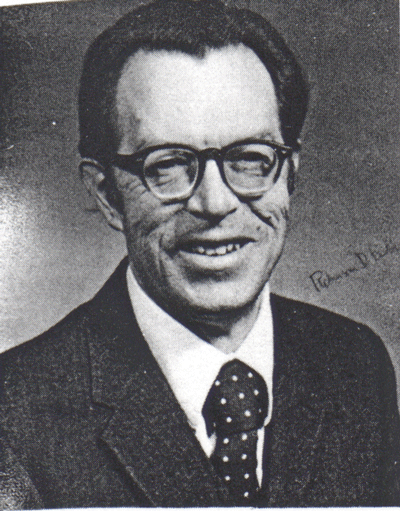 I was pleased to read in the Winter 1999 Newsletter of plans to celebrate the 50th anniversary of the ACA. I well remember some of the history behind this anniversary. I was pleased to read in the Winter 1999 Newsletter of plans to celebrate the 50th anniversary of the ACA. I well remember some of the history behind this anniversary.
In January, 1948 I joined the American Society for X-ray and Electron Diffraction at the instigation of my friend and colleague Howard Evans. In March, 1948 I attended my first ASXRED meeting at Yale. T he business meeting the planning was started for the scientific program for the first IUCr Congress coming up at Harvard later that summer. Can you imagine such a thing being contemplated today based on a lead time of barely four months? Life was simpler then and everything came out on schedule. Three Nobel Laureates attended the meeting. Peter Debye and Sir Chandrasekar Raman were lively and unpredictable participants in the technical sessions while Max Von Laue was elected honorary president of the IUCr. During the meeting informal talks were commenced between representatives of the ASXRED and the Crystallographic Society of America about combining their memberships into a single new society. These preliminary talks ultimately solidified into specific proposals following vigorous and sometimes acrimonious council meetings and business meetings of both societies in 1948 and 1949. In September, 1949 ballots for voting on the dissolution of the existing societies, a constitution for the new society, a choice of name for the society, and membership applications were distributed to the memberships. By a margin of over 10/1 the vote was for a new society. By a much smaller margin the favored name was the American Crystallographic Association. Thus, on January 1, 1950 the ASXRED and CSA ceased to exist and the ACA was born. Approximately 470 applicants became charter member of the ACA. It would be interesting if the society records can indicate how many of those charter members of more than 50 years ago are still ACA members today.
At the first ACA meeting held at Penn State in April, 1950 by far the principal attraction was Ray Pepinsky's X-RAC analogue computer. It performed the same functions as the Beevers-Lipson strips but the effect of adding each reflection and varying its phase could be seen immediately on an oscilloscope screen. There was a six foot tall electronic rack for each Miller index and the net result was a very large room completely filled with electronic racks and a prodigious number of vacuum tubes. Ray had a full time, and very temperamental technician who had to replace the tubes as they burned out to keep things running. For several years an international clientele of crystallographers made pilgrimages to Penn State with their data until the digital computer revolution caught up with and made the analogue approach obsolete.
Twenty five years ago in 1975 most of our founding fathers were still alive and many of our past presidents came to our 25th anniversary observance at the University of Virginia in March. At the banquet they were introduced in reverse order of seniority concluding with Maurice Huggins who had been the first ASXRED president in 1941. My esteemed friend Betty Wood gave an address about the early days which was so memorable and evocative that it elicited a much deserved standing ovation at it s conclusion. All in all it was a happy and sentimental occasion.
In the ensuing 25 years crystallography has evolved in ways quite beyond my imagination and competence except to note that they exceed our wildest dreams of those earlier times. The Good Lord willing I will endeavor to attend the 50th anniversary banquet this coming July 26th.
Jenny P. Glusker (ACA President - 1979)
 I first came to the US in September 1955 as a postdoc with Bob Corey at Caltech and then came East the next year (by car, missing the French Lick meeting) to Philadelphia to work with Lindo Patterson. As a result, my first American meeting was the IUCr meeting in Montreal, Canada, in 1957. What a wonderful meeting that was, and my best memories are of the day-long boat trip in which one could meet everyone on board, and the visit to the St. Lawrence Seaway construction (where I met Isidor Fankuchen). At the fall ACA meeting at the Mellon Institute I met Vladimir Vand. So, for me, the early ACA meetings were important because I could meet and talk with the crystallographers that I knew about only from their scientific articles and books. I first came to the US in September 1955 as a postdoc with Bob Corey at Caltech and then came East the next year (by car, missing the French Lick meeting) to Philadelphia to work with Lindo Patterson. As a result, my first American meeting was the IUCr meeting in Montreal, Canada, in 1957. What a wonderful meeting that was, and my best memories are of the day-long boat trip in which one could meet everyone on board, and the visit to the St. Lawrence Seaway construction (where I met Isidor Fankuchen). At the fall ACA meeting at the Mellon Institute I met Vladimir Vand. So, for me, the early ACA meetings were important because I could meet and talk with the crystallographers that I knew about only from their scientific articles and books.
In 1979, when I was President of ACA, there were two ACA meetings, one in Honolulu, Hawaii in March (at the University of Hawaii, just before the American Chemical Society meeting in the same city), and in Boston (at Boston University) in August. Before the meeting in Honolulu there had been a meeting on "Modulated Structures," suggested and organized by Carroll Johnson, at the King Kamehameha Hotel at Kailua Kona on the island of Hawaii. The Hawaii meeting, joint between the US, Japan and China, was the idea of Philip Coppens, the previous ACA President. It was my job to invite some Chinese crystallographers to the ACA meeting. This was not easy. The US did not have a Chinese Embassy in Washington in those days, only a Liaison Office. Letters to China went unanswered until I sent one in Chinese (with a covering letter explaining what I thought the letter said). Then came the reply that two Chinese crystallographers would attend, and Professor You-chi Tang was able to give a talk on the state of crystallography in China at that time. He asked me why I sent a letter in Chinese when he could read English. The opening of the ACA meeting was spectacular because the power failed throughout the entire university campus as I was introducing speakers in the Opening Ceremony, but it was restored in about half an hour. The other problem was a strike by United Airlines that left many on the island for longer than they had intended, but none were permanently stranded and some had interesting journeys home. However, we had Hawaiian dancing at the banquet with Linus Pauling as an honored guest.
The summer meeting in Boston concentrated on macromolecular crystallography, a subject that had not been well represented in some of the previous ACA meetings. Martha Ludwig arranged a magnificent program; for example, it included one of the first reports on Z-DNA (from its home base in Alex Rich's lab). The Warren Award, attended by Bert Warren, was given to Drs. Lytle, Sayers and Stern for their EXAFS work.
The science of crystallography has progressed rapidly through the last 50 years, and the memories of the people involved, their introduction of new ideas by scientific presentations at meetings and their friendly interactions with other scientists, young and old, have made the ACA the subject of great pride for all of us.
David Sayre (ACA President - 1983)
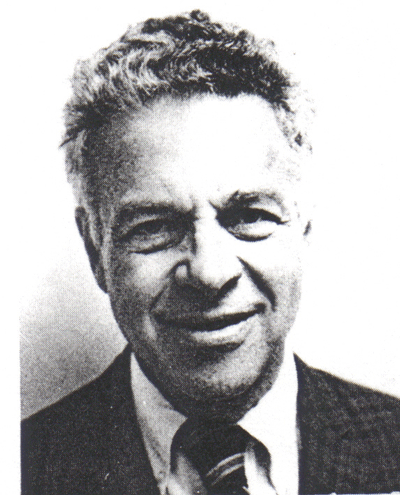 SOME REMINISCENCES: It was my good fortune, one day in 1947, when I was a graduate student at Harvard and very unsure of what I wanted to do, to come across the wartime review article on x-ray crystallography, in the Annual Reports on Progress in Physics of the Physical Society of London, by J.M. Robertson in Glasgow. Here I was, looking at a molecule (platinum phthalocyanine), and "seeing" every atom in it! In that instant I knew what I wanted to do, and in 53 more years the excitement has never worn off. SOME REMINISCENCES: It was my good fortune, one day in 1947, when I was a graduate student at Harvard and very unsure of what I wanted to do, to come across the wartime review article on x-ray crystallography, in the Annual Reports on Progress in Physics of the Physical Society of London, by J.M. Robertson in Glasgow. Here I was, looking at a molecule (platinum phthalocyanine), and "seeing" every atom in it! In that instant I knew what I wanted to do, and in 53 more years the excitement has never worn off.
The next year, now a member of Ray Pepinsky's group in Auburn Alabana, I attended my first crystallographic meeting, the March 1948 ASXRED meeting described in these reminiscences by Robinson Burbank; it was at that meeting that the plans for the ACA were made. Here are my memories of it, written recently as part of some personal reminiscences:
"Another important part of my Auburn experience was that of beginning to become acquainted with the crystallographers of America and the world. This was something in which Ray acted very thoughtfully and generously in our behalf. In March 1948 a small delegation of us from Auburn traveled to Yale to take part in what was for me my first crystallographic meeting, and there I could see and listen to most of the notable American crystallographers: from Bryn Mawr, A.L. Patterson himself; from Brooklyn Polytechnic, Isidor Fankuchen; from MIT, Martin Buerger and Bert Warren; from Johns Hopkins, Jose Donnay; from the University of Chicago, William Zachariasen; from Cal Tech, Linus Pauling, Eddie Hughes, and Verner Schomaker; to name only a few of the best-known of the perhaps 50 persons there. I was struck on this occasion by what I never failed to be struck by again and again through the years: the extraordinarily high technical and human quality found in this small field of science. In those days, with no need for parallel or poster sessions, every paper was spoken, and heard with attentiveness. At the end of the paper, someone (usually one of the senior group) would comment unhurriedly and informatively on what we had heard; someone else would speak; and serious general discussion and give-and-take would follow. These were old friends, who knew and loved their subject, and valued one another's' opinions."
(From Rob Burbank, by the way, I learn how imperfect my memory is in some ways. There were actually 205 crystallographers present, and Pauling did not attend, though Jerry Donahue was present and spoke.)
Also in the summer of 1948 I attended the 1st IUCr Congress which took place at Harvard. Rob refers to Sir Chandrasekar Raman as one of the notables at that meeting, and describes them as being gifted with unpredictability. How true! Raman's talk was on the structure of diamonds, and partway through his talk he reached absent-mindedly into his pocket, took out a diamond about the size of a pigeon's egg and tossed it idly from hand to hand for the remainder of his talk. You may be sure that every eye was on him.
My year as president of the ACA was 1983, following Jerry Cohen and being followed by David Templeton. Our 1983 meetings were in Columbia, Missouri and Snowmass, Colorado. At that time Council's major concern was that crystallography might find itself drifting into being a technique only, and thus in danger of becoming a second-order participant in the sciences to which it would be contributing; to that end we sought to identify the ACA with a higher concept of how our subject might operate in science. That effort I think has been continuously maintained in the ACA, and when I look at the work being done by crystallographers today I feel that the danger has truly been averted.
Our 1984 meeting was in Lexington, Kentucky, where following tradition I had to give the past-presidential talk. I expect that my talk has been pretty well forgotten, but I know there are many who still remember the talk about Rosalind Franklin which my wife Anne gave at that meeting. Anne is gone now, having died in March 1998, and I will never cease to be grateful that the ACA asked me to provide an obituary of her for inclusion in the ACA Newsletter. Although Anne was a not a scientist, she loved and understood the caring which crystallographers give to each other and to their subject, and being herself included in that caring by the ACA would have moved her deeply.
As I look back over the last 53 years, I see a subject — initially small but beautiful, deeply contributive to science, and lovingly practiced — continuing its development amazingly further, and doing so in a manner still true to its origins. The work in which I have been engaged in recent years convinces me that when we have run out of crystals there will still exist almost limitless areas for continued growth. I feel deeply fortunate that this beautiful field has been a major part of my life.
Bill Duax (ACA President - 1986)
 Some people have accused me of installing myself as ACA President for life and I appreciate the fact that so many ACA Presidents have been tolerant of my often meddlesome presence. I'm sorry, I just can't help myself. Crystallography seems to be my raison d'etre. The beauty of the discipline and the people it attracts continues to enrich my life to an extraordinary degree. When I think of my life in the ACA I see a flood of images. At my first meeting after my first talk David Harker spoke a kind word to me. At the time I didn't recognize him and my thesis advisor Norman Baenzinger had to tell me that it was the David Harker that I read about in text books. I learned that "kind words" were not what David was most famous for at ACA meetings. A few years later I was puzzled when David stood up in the audience at the annual meeting and berated a couple of speakers for not understanding the principal of homometric solutions (the speakers were a couple of whipper snappers named Karle and Hauptman). A few years later when I suggested that the ACA start holding only one meeting a year, I vividly recall Sidney Abrahams telling the attendees at the business meeting that "if Bill Duax doesn't like coming to two ACA meetings a year he doesn't need to come to ACA meetings at all". Smarting from the remark (I always took things too personally) I was tempted to leave the ACA but Jenny Glusker (ever my good angel) persuaded me that Sidney meant no harm. Jenny was almost always right. A few years later Jenny talked me into being a write-in candidate for ACA president, perhaps the only occasion in which a write-in candidate appeared on a ballot. As a consequence the ACA office had to hold a run-off election, wasting paper and postage to elect one of the original candidates. Some people have accused me of installing myself as ACA President for life and I appreciate the fact that so many ACA Presidents have been tolerant of my often meddlesome presence. I'm sorry, I just can't help myself. Crystallography seems to be my raison d'etre. The beauty of the discipline and the people it attracts continues to enrich my life to an extraordinary degree. When I think of my life in the ACA I see a flood of images. At my first meeting after my first talk David Harker spoke a kind word to me. At the time I didn't recognize him and my thesis advisor Norman Baenzinger had to tell me that it was the David Harker that I read about in text books. I learned that "kind words" were not what David was most famous for at ACA meetings. A few years later I was puzzled when David stood up in the audience at the annual meeting and berated a couple of speakers for not understanding the principal of homometric solutions (the speakers were a couple of whipper snappers named Karle and Hauptman). A few years later when I suggested that the ACA start holding only one meeting a year, I vividly recall Sidney Abrahams telling the attendees at the business meeting that "if Bill Duax doesn't like coming to two ACA meetings a year he doesn't need to come to ACA meetings at all". Smarting from the remark (I always took things too personally) I was tempted to leave the ACA but Jenny Glusker (ever my good angel) persuaded me that Sidney meant no harm. Jenny was almost always right. A few years later Jenny talked me into being a write-in candidate for ACA president, perhaps the only occasion in which a write-in candidate appeared on a ballot. As a consequence the ACA office had to hold a run-off election, wasting paper and postage to elect one of the original candidates.
 When I was elected president in 1986 the annual meeting was held at McMaster University in Hamilton, Ontario, Canada. The local chair I. David Brown and program chair Martha Teeter did a wonderful job. It was the first meeting after the announcement of Hauptman and Karle's Nobel Prize in Chemistry and Robert Bryan masterfully chaired a session in which he said that the H, K, and L of crystallography were the sessions speakers (Hauptman, Karle and Linus). Jane Griffin chaired the transaction symposium on Hydrogen Bonds that year and we broke tradition and presented the Fankuchen award on the last day of the meeting rather than the opening session to accommodate the hectic schedule of Michael Rossman who mesmerized the audience with his lecture of a spherical RNA virus. A wonderful memory from my past president years was having Dorothy Hodgkin present at the Austin meeting to present the first Pauling Prize awards to young crystallographers at the dinner. At the same dinner someone in a gorilla suit sent by the "women of crystallography" delivered a bouquet of balloons to me and I finished my past president talk by somersaulting down the center of the banquet hall. The Philadelphia meeting in 1988 was another high water mark in my memory. The presence of six Nobel Laureates (Hodgkin, Pauling, Lipscomb, Hauptman, Karle and Kendrew) drew an attendance of nearly twice that of previous year. When I was elected president in 1986 the annual meeting was held at McMaster University in Hamilton, Ontario, Canada. The local chair I. David Brown and program chair Martha Teeter did a wonderful job. It was the first meeting after the announcement of Hauptman and Karle's Nobel Prize in Chemistry and Robert Bryan masterfully chaired a session in which he said that the H, K, and L of crystallography were the sessions speakers (Hauptman, Karle and Linus). Jane Griffin chaired the transaction symposium on Hydrogen Bonds that year and we broke tradition and presented the Fankuchen award on the last day of the meeting rather than the opening session to accommodate the hectic schedule of Michael Rossman who mesmerized the audience with his lecture of a spherical RNA virus. A wonderful memory from my past president years was having Dorothy Hodgkin present at the Austin meeting to present the first Pauling Prize awards to young crystallographers at the dinner. At the same dinner someone in a gorilla suit sent by the "women of crystallography" delivered a bouquet of balloons to me and I finished my past president talk by somersaulting down the center of the banquet hall. The Philadelphia meeting in 1988 was another high water mark in my memory. The presence of six Nobel Laureates (Hodgkin, Pauling, Lipscomb, Hauptman, Karle and Kendrew) drew an attendance of nearly twice that of previous year.
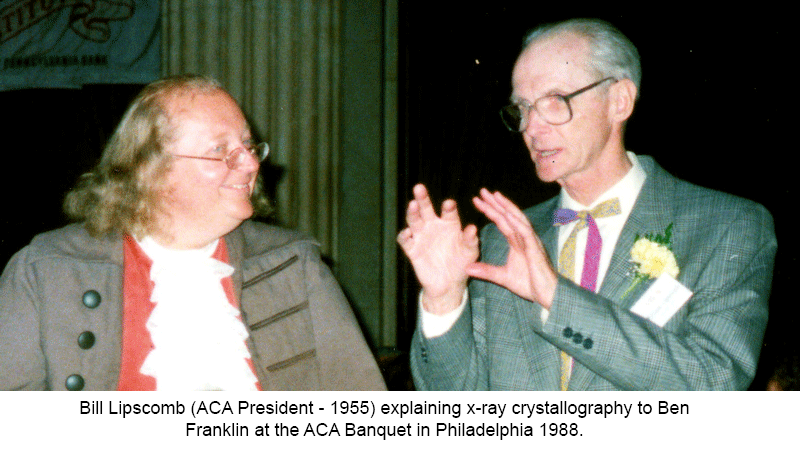 If anyone wants to know who to blame for saddling the ACA with me as a volunteer CEO, the guilty party is Catherine Foris who not only served as a splendid treasurer but paved the way for the election of her successor Rao. During my year as president the ACA office was transferred to Buffalo and a new era began. The ACA office began in Buffalo with the help of Debbie Savage and has continued to grow and serve the expanding the needs of the membership under the capable direction of the marvelous Marcia Evans and her staff. While the ACA continues to thrive due to the volunteer efforts of a great many individuals as officers, program and local chairs of the annual meetings and editors of its newsletters, the value of an office with a full time staff has become abundantly clear. The importance of the powerful discipline of crystallography to the infrastructure of science requires a support structure equal to the task of serving the science and its practitioners. A 50th anniversary meeting might be a good place to gather and discuss the future of the ACA. If anyone wants to know who to blame for saddling the ACA with me as a volunteer CEO, the guilty party is Catherine Foris who not only served as a splendid treasurer but paved the way for the election of her successor Rao. During my year as president the ACA office was transferred to Buffalo and a new era began. The ACA office began in Buffalo with the help of Debbie Savage and has continued to grow and serve the expanding the needs of the membership under the capable direction of the marvelous Marcia Evans and her staff. While the ACA continues to thrive due to the volunteer efforts of a great many individuals as officers, program and local chairs of the annual meetings and editors of its newsletters, the value of an office with a full time staff has become abundantly clear. The importance of the powerful discipline of crystallography to the infrastructure of science requires a support structure equal to the task of serving the science and its practitioners. A 50th anniversary meeting might be a good place to gather and discuss the future of the ACA.
Charles E. Bugg (ACA President - 1987)
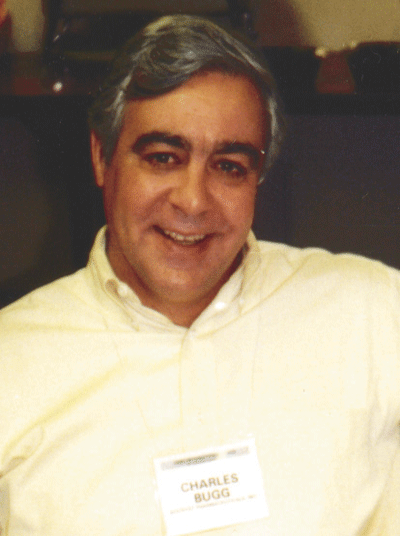 Thank you very much for your letter informing me of the get-together for the past ACA presidents at the meeting this summer in St. Paul. I am planning on attending the banquet on the evening of Wednesday, July 26, and I will be looking forward to seeing you and many of my other friends who have served the ACA with such enthusiasm over the years. Thank you very much for your letter informing me of the get-together for the past ACA presidents at the meeting this summer in St. Paul. I am planning on attending the banquet on the evening of Wednesday, July 26, and I will be looking forward to seeing you and many of my other friends who have served the ACA with such enthusiasm over the years.
My main impression of crystallography during my brief career is WOW! I feel extremely fortunate to have been in this exciting field during two major revolutions in the field of crystal structure analysis, first in small molecule crystallography during the 1970's, and then in protein crystallography during the 1990's. As a graduate student during the early 1960's, my Ph.D. thesis involved solving the crystal structures of two extremely small organic molecules, which I considered a major accomplishment at the time. Clearly, this would take well under a week with today's techniques. At about the time that I was President of the ACA, we enjoyed a similar transition point in protein crystallography, as the Protein Data Bank began its sharp transition from flat growth to the exponential growth that we have today.
I feel equally fortunate to be participating now in another revolution in applications of crystallography, including development of more and more effective ways of using the power of crystallography in the design of unique pharmaceuticals that are addressing many major medical problems. Hopefully, I am still young enough to see a couple of additional revolutions occur using our very powerful science before they put me in the grave!
Many thanks to you and to the ACA for organizing this wonderful opportunity for us to get together in St. Paul. I'll see you there.
Helen M. Berman (ACA President - 1988)
 ACA memories: The ACA is a very special organization that provides vehicles for learning about the latest developments in crystallography, watching the field evolve, and making friends that can last a lifetime. I feel lucky that I became involved with it at an early stage of my career having attended my first meeting in 1965 while still a student at the University of Pittsburgh. When I gave my first talk I remember how happy I was when Lindo Patterson asked me a question. I also remember the meeting in Atlanta when the first "American" protein crystal structure-ribonuclease was described. ACA memories: The ACA is a very special organization that provides vehicles for learning about the latest developments in crystallography, watching the field evolve, and making friends that can last a lifetime. I feel lucky that I became involved with it at an early stage of my career having attended my first meeting in 1965 while still a student at the University of Pittsburgh. When I gave my first talk I remember how happy I was when Lindo Patterson asked me a question. I also remember the meeting in Atlanta when the first "American" protein crystal structure-ribonuclease was described.
In 1971 when I was not yet 30 and had been going to ACA meetings for six years, I began to realize that those meetings could be an important forum for "making important things happen". I got together with a group of like-minded colleagues and we had a grass roots meeting to encourage the ACA to help establish a protein data bank. We had a meeting in Columbia, South Carolina and many people signed a petition endorsing such an effort. After the PDB was in fact established at Brookhaven, the ACA did indeed give it its sponsorship (unfunded of course) and for many years the PDB sent regular reports to the ACA.
In those early years the young folks including myself, Bill Duax, and Judy Flippen-Anderson among others were full of new ideas that eventually became part of the mainstream. We came faithfully to the business meetings where we argued our causes and occasionally even won. Notable successes were the establishment of poster sessions (complete with beer), once a year meetings (rather than two), SIGS, and Continuing Education Workshops.

Ned Seeman, Joel Sussman, Helen Berman and Sung Ho Kim holding early discussions about the PDB
Eventually we all turned 40 and became part of the establishment. This earned us the right to be in charge of things. And so in 1987 I had the honor of being Program Chair for the Austin meeting. In addition to organizing the scientific content of the program, we had to cut and paste (with scissors and glue) the abstracts onto big layout sheets so that they could be photographed for inclusion in the Abstract book. This was an exhausting task and I was lucky that Judy came up to Philadelphia to help after I convinced her that this was good training for when she would be a Program Chair the next year.
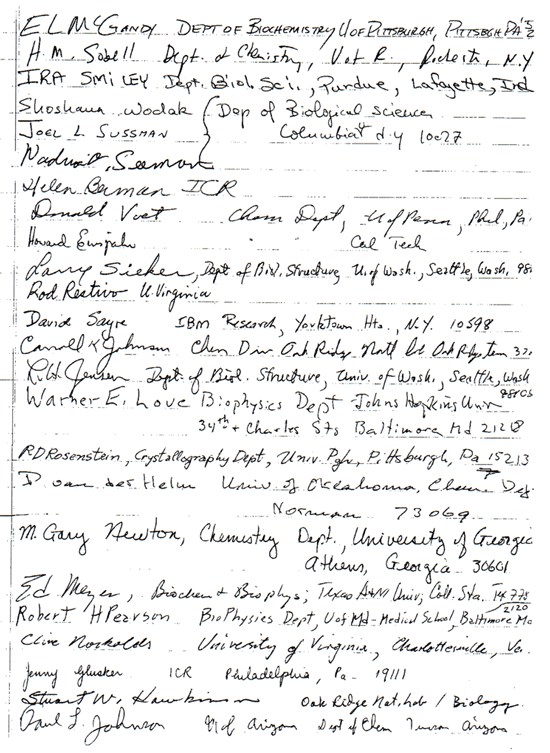
Part of the original petition to start the PDB that was submitted to the ACA.
Then in 1988 I presided over the Philadelphia meeting as President of the ACA which was attended by a record number of people including a pretty good facsimile of Benjamin Franklin.
George Jeffrey, Ben Franklin and Helen at the ACA
banquet in Philadelphia - 1988.
For logistical reasons, I did not get to give my Past President's speech at the 1989 Seattle meeting and so Bryan Craven had me give it in 1990 in New Orleans (thereby missing his chance to do this dreaded duty). Afterwards Bill Duax decided to present me with a series of honors including a pink feather boa and some other unmentionable prizes.
Once I finished with my ACA Council duties, I found myself in new projects. I worked with Paula Fitzgerald who patiently and courageously led the creation of the mmCIF dictionary- a project that we thought would take a weekend and took almost eight years. But there were rewards; among those were that we got to eat in lots of neat restaurants and we were mostly right about which ones would last.
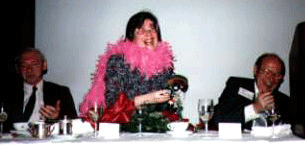
Michael Woolfson, Helen (with feathered friend), and Dave Duchamp at the ACA banquet in New Orleans - 1990.
Being part of the ACA for 35 years has been fun, hard work, and often times rewarding. I learned a lot of new science by attending talks and posters. I also learned about the interplay of community and science that has been invaluable for my present responsibilities directing the PDB.
Back to top
Commercial Exhibitor Memoirs
Sue Byram (Syntex - Nicolet - Siemens - Bruker) says that the earliest evidence she can find for exhibiting with the ACA was in Ottawa in 1970. She found some photos that chronicle her professional evolution / metamorphosis! Top photo is a beardless Bob Sparks (circa early 70's); next is Godfrey Crane (mid-70's); then Sue, Omar Lutfey, Rod Cook and Rich Peach (Pittsburgh - 1992) and finally Sue in Arlington, VA (1998).
Siemens
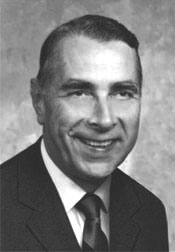 From Charles Supper, Inc. Lee Supper remembers the 1st ACA meeting in State College PA in April of 1950. "This meeting was an important event for Charles Supper Company. Dad had never had an opportunity to meet and talk with so many potential customers about his product line of cameras and goniometer heads. He and Mother shared booth duty - as a 12 year old I was the gopher. I remember a few nights of the three of us at our dining room table putting mimeographed descriptions of the products into a cover he had printed for the meeting. From Charles Supper, Inc. Lee Supper remembers the 1st ACA meeting in State College PA in April of 1950. "This meeting was an important event for Charles Supper Company. Dad had never had an opportunity to meet and talk with so many potential customers about his product line of cameras and goniometer heads. He and Mother shared booth duty - as a 12 year old I was the gopher. I remember a few nights of the three of us at our dining room table putting mimeographed descriptions of the products into a cover he had printed for the meeting.
Aside from our little firm, Otto von der Hyde also exhibited. Otto and Dad were friendly competitors, having met in 1924 when they were both entering the United States from Germany. Each Mammoth Cave National Park, heading to Newfoundland for the summer).
The commercial attendees were located in one room in either an Inn (Nittany Lion?) or a campus house. Each exhibitor had one or two card tables for brochures. It was all very congenial - Otto, who was an accomplished pianist, played a grand piano every night, even getting into popular songs and song fests. Phillips (Jack Washburn) had at least one cocktail party which we know became a Phillips and ACA tradition (I only heard about the party).
These simple arrangements for commercial exhibitors continued for perhaps a dozen years or so. They are greatly missed by this writer."
From Bert Frenz of B. A. Frenz &Assoc: "Any photos I may have are buried in a storage unit where we moved all our household possessions about 18 months ago. Since then we have been traveling full-time in our motor home (right now we are at Mammoth Cave National Park, heading to Newfoundland for the summer).
I started on the commercial side of ACA right after my postdoctoral position at Texas A&M and I probably participated in my first commercial exhibit in 1975 when I promoted the SDP software through Enraf-Nonius.
I don't recall any particular stories of the ACA commercial exhibits at that time, but one theme was consistent through the early days of my experiences. It seems that whatever I was promoting was always a bit ahead of the times and not quite accepted. When I promoted running crystallographic software on minicomputers, crystallographers could not envision leaving their mainframes. When I proposed switching from PDP-11 mini-computers to VAX-11 computers, Enraf-Nonius didn't support the move. When I began my work with microcomputers - starting with the IBM-AT - I met many naysayers who were firmly in bed with their VAX computers. And then, even when small molecule crystallographers had adopted minicomputers, their macromolecular counterparts hesitated at my suggestion to leave their workstations for less expensive minicomputers. All of this seems hard to believe now that small personal computers are an everyday part of our lives and crystallographic calculations spin off our notebook computers as fast as arithmetic on a hand calculator in the early 70s."
Molecular Structure Corporation (MSC) is another long time ACA commercial exhibitor and corporate member. The year 2000 marked the 17th anniversary of their annual Fun Run. - the T-shirts were instituted in 1985. The photo below shows some very happy (that it's over) runners in 1997 in St. Louis, MO in the memorable tie-dyed T-shirts.
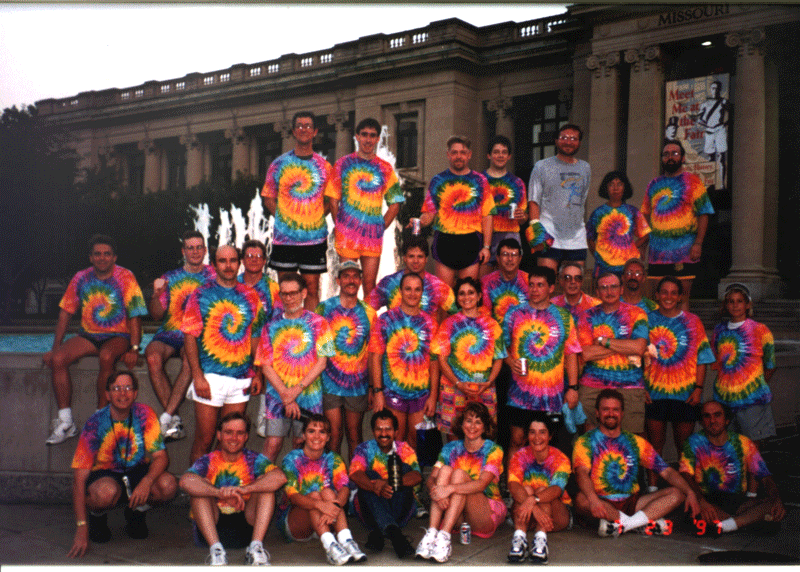
Nostalgia
Name that Crystallographer
From Reuben Rudman: It was February 1977, the world was young (or at least I was younger), and it was the ACA Meeting at Asilomar, Pacific Grove, California. Linus Pauling was in attendance and Dorothy Hodgkin was the recipient of the Third Fankuchen Award. My book on "Low-Temperature X-Ray Diffraction: Apparatus and Techniques" had just appeared and I had organized a tutorial on the subject. At one session I had a copy of the book with me and found myself sitting next to Linus Pauling. On the spur of the moment I asked him to autograph the flyleaf of the book, which he graciously did. Later that meeting I asked Dorothy Hodgkin to autograph it too.
Following that auspicious beginning, I began to carry the book with me to various crystallographic meetings. During the past 22 years many of the best known names in crystallography have kindly added their signatures to that page. A copy of the page is printed here for your perusal. How many signatures can you identify? Can you also identify their contributions to our field?
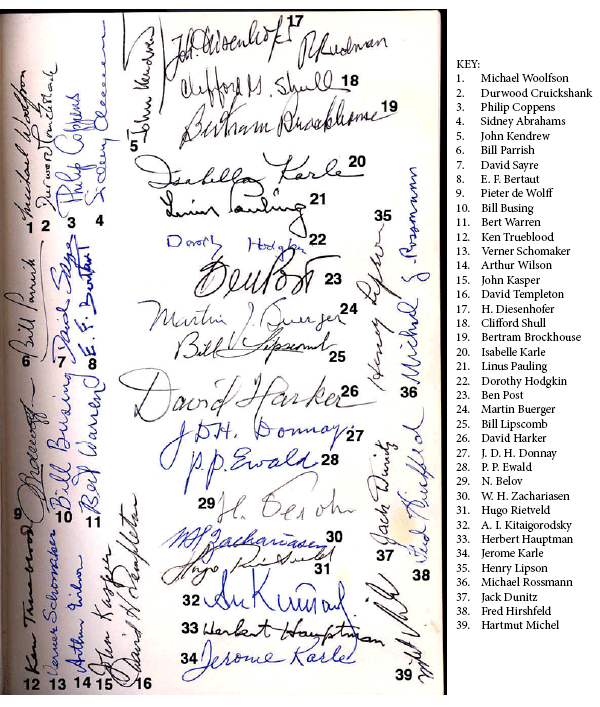
|
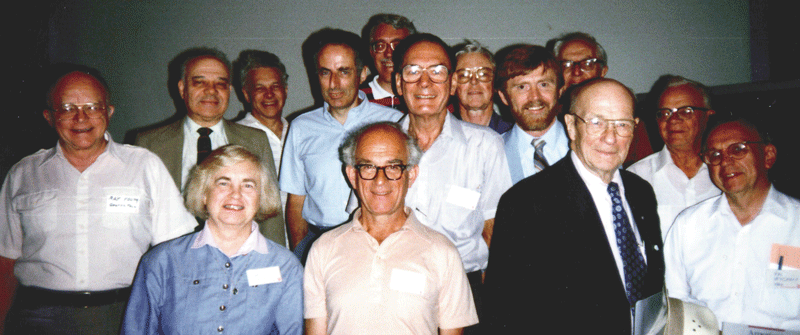
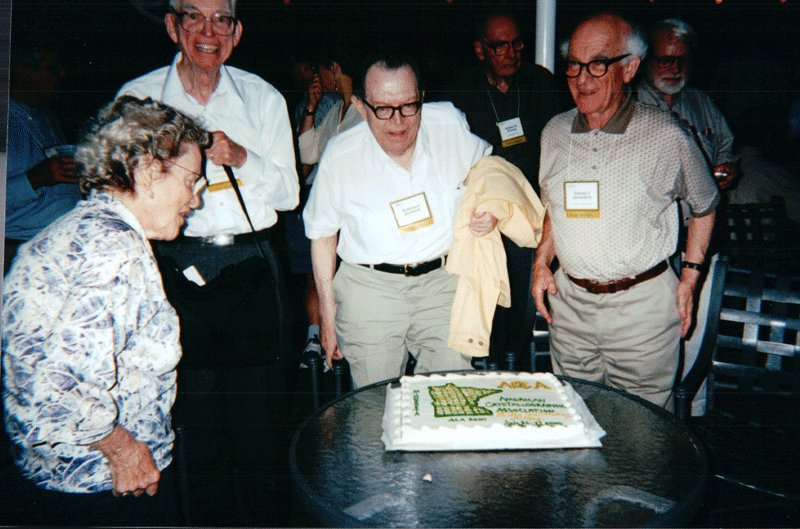
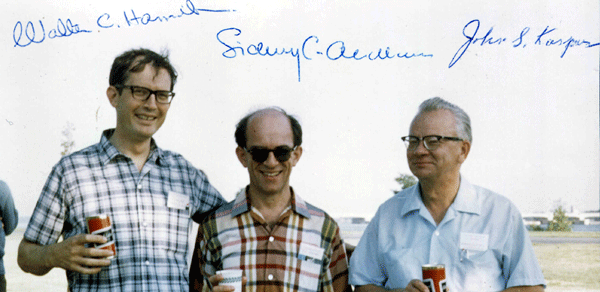
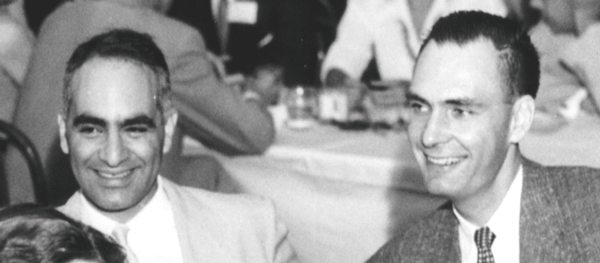

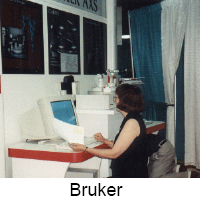
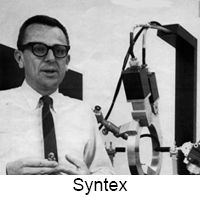
 From Charles Supper, Inc. Lee Supper remembers the 1st ACA meeting in State College PA in April of 1950. "This meeting was an important event for Charles Supper Company. Dad had never had an opportunity to meet and talk with so many potential customers about his product line of cameras and goniometer heads. He and Mother shared booth duty - as a 12 year old I was the gopher. I remember a few nights of the three of us at our dining room table putting mimeographed descriptions of the products into a cover he had printed for the meeting.
From Charles Supper, Inc. Lee Supper remembers the 1st ACA meeting in State College PA in April of 1950. "This meeting was an important event for Charles Supper Company. Dad had never had an opportunity to meet and talk with so many potential customers about his product line of cameras and goniometer heads. He and Mother shared booth duty - as a 12 year old I was the gopher. I remember a few nights of the three of us at our dining room table putting mimeographed descriptions of the products into a cover he had printed for the meeting.


 Rob Burbank's excellent letter covers much that I had remembered. He and I met at a meeting of the American Society for X-ray and Electron Diffraction in 1948 and have kept in touch ever since. That society was so small that the members all knew each other. We met at such places as Gibson Island and a small hotel on Lake George and enjoyed outdoor recreation together.
Rob Burbank's excellent letter covers much that I had remembered. He and I met at a meeting of the American Society for X-ray and Electron Diffraction in 1948 and have kept in touch ever since. That society was so small that the members all knew each other. We met at such places as Gibson Island and a small hotel on Lake George and enjoyed outdoor recreation together. John and I wish to thank you for your invitation for him to attend the 50th Anniversary Meeting of the ACA in St. Paul. We regret it is not possible for us to attend. John has been legally blind for many years and suffered a stroke 3 years ago that left him able to walk around, but his mind was not so lucky. His memory is very poor and he has trouble finding words to communicate. He knows he was once president of ACA but his memory of that year (1967) is gone. He does not have the strength to travel. The end of March he had a second melanoma removed from his eye and is still recovering from that surgery.
John and I wish to thank you for your invitation for him to attend the 50th Anniversary Meeting of the ACA in St. Paul. We regret it is not possible for us to attend. John has been legally blind for many years and suffered a stroke 3 years ago that left him able to walk around, but his mind was not so lucky. His memory is very poor and he has trouble finding words to communicate. He knows he was once president of ACA but his memory of that year (1967) is gone. He does not have the strength to travel. The end of March he had a second melanoma removed from his eye and is still recovering from that surgery. Recollections of the ACA at Penn State, Tucson & Buffalo 1968: Ralph Wyckoff, second president of the ACA, told the Tucson meeting in 1968 that "he was struck by the lack of a sense of history, not only in the outlook of students but in the way science is taught." He went on to say that we should realize we live in a moment of time with important characteristics set by all that has gone before and that we can only perceive the real meaning of our efforts if we appreciate how we come to be making them. The present recollections are not the place for such an overview, beneficial as they might be. Instead they offer brief looks at the 1968 period, when it was my privilege to serve as ACA president, at our first meeting in 1950, and at our most recent meeting in Buffalo as a comparison in miniature.
Recollections of the ACA at Penn State, Tucson & Buffalo 1968: Ralph Wyckoff, second president of the ACA, told the Tucson meeting in 1968 that "he was struck by the lack of a sense of history, not only in the outlook of students but in the way science is taught." He went on to say that we should realize we live in a moment of time with important characteristics set by all that has gone before and that we can only perceive the real meaning of our efforts if we appreciate how we come to be making them. The present recollections are not the place for such an overview, beneficial as they might be. Instead they offer brief looks at the 1968 period, when it was my privilege to serve as ACA president, at our first meeting in 1950, and at our most recent meeting in Buffalo as a comparison in miniature. My recollections don't go as far back as Rob Burbank's, but I do remember my first ACA meeting at French Lick, IN, in 1956. At that meeting Joan Clark reported on what I believe was the first crystal structure determined entirely by direct methods. (I think the authors were Clark and Crist and perhaps Howard Evans. At this point I don't have the facilities to look it up.) Someone, probably Ray Pepinsky, asked what the Patterson map looked like, and when Joan said they hadn't made a Patterson, there was a general gasp of surprise.
My recollections don't go as far back as Rob Burbank's, but I do remember my first ACA meeting at French Lick, IN, in 1956. At that meeting Joan Clark reported on what I believe was the first crystal structure determined entirely by direct methods. (I think the authors were Clark and Crist and perhaps Howard Evans. At this point I don't have the facilities to look it up.) Someone, probably Ray Pepinsky, asked what the Patterson map looked like, and when Joan said they hadn't made a Patterson, there was a general gasp of surprise. Fifty years plus: We became familiar with the electron diffraction and X-ray diffraction communities during the 1940s. There was at least one meeting of the Crystallographic Society of America at the University of Michigan during the 1944-46 period. Isabella was there during that period as a member of the chemistry faculty and Jerome was employed there by the Naval Research Laboratory on a World War II project. This was when we first met Martin Buerger and Lindo Patterson. David Harker, Jose Donnay, William Zachariasen and Isidor Fankuchen were also there. There were additional meetings of the Crystallographic Society of America and also meetings of the newer society called The American Society for X-Ray and Electron Diffraction (ASXED) until 1950 when the American Crystallographic Association was formed from a merging of the above two organizations. After the war, Paul Ewald joined Fankuchen at the Polytechnic Institute of Brooklyn and added his presence to the meetings. Our thesis professor, Lawrence Brockway, a major figure in gas electron diffraction, was also an attendee at the meetings.
Fifty years plus: We became familiar with the electron diffraction and X-ray diffraction communities during the 1940s. There was at least one meeting of the Crystallographic Society of America at the University of Michigan during the 1944-46 period. Isabella was there during that period as a member of the chemistry faculty and Jerome was employed there by the Naval Research Laboratory on a World War II project. This was when we first met Martin Buerger and Lindo Patterson. David Harker, Jose Donnay, William Zachariasen and Isidor Fankuchen were also there. There were additional meetings of the Crystallographic Society of America and also meetings of the newer society called The American Society for X-Ray and Electron Diffraction (ASXED) until 1950 when the American Crystallographic Association was formed from a merging of the above two organizations. After the war, Paul Ewald joined Fankuchen at the Polytechnic Institute of Brooklyn and added his presence to the meetings. Our thesis professor, Lawrence Brockway, a major figure in gas electron diffraction, was also an attendee at the meetings. I was pleased to read in the Winter 1999 Newsletter of plans to celebrate the 50th anniversary of the ACA. I well remember some of the history behind this anniversary.
I was pleased to read in the Winter 1999 Newsletter of plans to celebrate the 50th anniversary of the ACA. I well remember some of the history behind this anniversary. I first came to the US in September 1955 as a postdoc with Bob Corey at Caltech and then came East the next year (by car, missing the French Lick meeting) to Philadelphia to work with Lindo Patterson. As a result, my first American meeting was the IUCr meeting in Montreal, Canada, in 1957. What a wonderful meeting that was, and my best memories are of the day-long boat trip in which one could meet everyone on board, and the visit to the St. Lawrence Seaway construction (where I met Isidor Fankuchen). At the fall ACA meeting at the Mellon Institute I met Vladimir Vand. So, for me, the early ACA meetings were important because I could meet and talk with the crystallographers that I knew about only from their scientific articles and books.
I first came to the US in September 1955 as a postdoc with Bob Corey at Caltech and then came East the next year (by car, missing the French Lick meeting) to Philadelphia to work with Lindo Patterson. As a result, my first American meeting was the IUCr meeting in Montreal, Canada, in 1957. What a wonderful meeting that was, and my best memories are of the day-long boat trip in which one could meet everyone on board, and the visit to the St. Lawrence Seaway construction (where I met Isidor Fankuchen). At the fall ACA meeting at the Mellon Institute I met Vladimir Vand. So, for me, the early ACA meetings were important because I could meet and talk with the crystallographers that I knew about only from their scientific articles and books. SOME REMINISCENCES: It was my good fortune, one day in 1947, when I was a graduate student at Harvard and very unsure of what I wanted to do, to come across the wartime review article on x-ray crystallography, in the Annual Reports on Progress in Physics of the Physical Society of London, by J.M. Robertson in Glasgow. Here I was, looking at a molecule (platinum phthalocyanine), and "seeing" every atom in it! In that instant I knew what I wanted to do, and in 53 more years the excitement has never worn off.
SOME REMINISCENCES: It was my good fortune, one day in 1947, when I was a graduate student at Harvard and very unsure of what I wanted to do, to come across the wartime review article on x-ray crystallography, in the Annual Reports on Progress in Physics of the Physical Society of London, by J.M. Robertson in Glasgow. Here I was, looking at a molecule (platinum phthalocyanine), and "seeing" every atom in it! In that instant I knew what I wanted to do, and in 53 more years the excitement has never worn off. Some people have accused me of installing myself as ACA President for life and I appreciate the fact that so many ACA Presidents have been tolerant of my often meddlesome presence. I'm sorry, I just can't help myself. Crystallography seems to be my raison d'etre. The beauty of the discipline and the people it attracts continues to enrich my life to an extraordinary degree. When I think of my life in the ACA I see a flood of images. At my first meeting after my first talk David Harker spoke a kind word to me. At the time I didn't recognize him and my thesis advisor Norman Baenzinger had to tell me that it was the David Harker that I read about in text books. I learned that "kind words" were not what David was most famous for at ACA meetings. A few years later I was puzzled when David stood up in the audience at the annual meeting and berated a couple of speakers for not understanding the principal of homometric solutions (the speakers were a couple of whipper snappers named Karle and Hauptman). A few years later when I suggested that the ACA start holding only one meeting a year, I vividly recall Sidney Abrahams telling the attendees at the business meeting that "if Bill Duax doesn't like coming to two ACA meetings a year he doesn't need to come to ACA meetings at all". Smarting from the remark (I always took things too personally) I was tempted to leave the ACA but Jenny Glusker (ever my good angel) persuaded me that Sidney meant no harm. Jenny was almost always right. A few years later Jenny talked me into being a write-in candidate for ACA president, perhaps the only occasion in which a write-in candidate appeared on a ballot. As a consequence the ACA office had to hold a run-off election, wasting paper and postage to elect one of the original candidates.
Some people have accused me of installing myself as ACA President for life and I appreciate the fact that so many ACA Presidents have been tolerant of my often meddlesome presence. I'm sorry, I just can't help myself. Crystallography seems to be my raison d'etre. The beauty of the discipline and the people it attracts continues to enrich my life to an extraordinary degree. When I think of my life in the ACA I see a flood of images. At my first meeting after my first talk David Harker spoke a kind word to me. At the time I didn't recognize him and my thesis advisor Norman Baenzinger had to tell me that it was the David Harker that I read about in text books. I learned that "kind words" were not what David was most famous for at ACA meetings. A few years later I was puzzled when David stood up in the audience at the annual meeting and berated a couple of speakers for not understanding the principal of homometric solutions (the speakers were a couple of whipper snappers named Karle and Hauptman). A few years later when I suggested that the ACA start holding only one meeting a year, I vividly recall Sidney Abrahams telling the attendees at the business meeting that "if Bill Duax doesn't like coming to two ACA meetings a year he doesn't need to come to ACA meetings at all". Smarting from the remark (I always took things too personally) I was tempted to leave the ACA but Jenny Glusker (ever my good angel) persuaded me that Sidney meant no harm. Jenny was almost always right. A few years later Jenny talked me into being a write-in candidate for ACA president, perhaps the only occasion in which a write-in candidate appeared on a ballot. As a consequence the ACA office had to hold a run-off election, wasting paper and postage to elect one of the original candidates. When I was elected president in 1986 the annual meeting was held at McMaster University in Hamilton, Ontario, Canada. The local chair I. David Brown and program chair Martha Teeter did a wonderful job. It was the first meeting after the announcement of Hauptman and Karle's Nobel Prize in Chemistry and Robert Bryan masterfully chaired a session in which he said that the H, K, and L of crystallography were the sessions speakers (Hauptman, Karle and Linus). Jane Griffin chaired the transaction symposium on Hydrogen Bonds that year and we broke tradition and presented the Fankuchen award on the last day of the meeting rather than the opening session to accommodate the hectic schedule of Michael Rossman who mesmerized the audience with his lecture of a spherical RNA virus. A wonderful memory from my past president years was having Dorothy Hodgkin present at the Austin meeting to present the first Pauling Prize awards to young crystallographers at the dinner. At the same dinner someone in a gorilla suit sent by the "women of crystallography" delivered a bouquet of balloons to me and I finished my past president talk by somersaulting down the center of the banquet hall. The Philadelphia meeting in 1988 was another high water mark in my memory. The presence of six Nobel Laureates (Hodgkin, Pauling, Lipscomb, Hauptman, Karle and Kendrew) drew an attendance of nearly twice that of previous year.
When I was elected president in 1986 the annual meeting was held at McMaster University in Hamilton, Ontario, Canada. The local chair I. David Brown and program chair Martha Teeter did a wonderful job. It was the first meeting after the announcement of Hauptman and Karle's Nobel Prize in Chemistry and Robert Bryan masterfully chaired a session in which he said that the H, K, and L of crystallography were the sessions speakers (Hauptman, Karle and Linus). Jane Griffin chaired the transaction symposium on Hydrogen Bonds that year and we broke tradition and presented the Fankuchen award on the last day of the meeting rather than the opening session to accommodate the hectic schedule of Michael Rossman who mesmerized the audience with his lecture of a spherical RNA virus. A wonderful memory from my past president years was having Dorothy Hodgkin present at the Austin meeting to present the first Pauling Prize awards to young crystallographers at the dinner. At the same dinner someone in a gorilla suit sent by the "women of crystallography" delivered a bouquet of balloons to me and I finished my past president talk by somersaulting down the center of the banquet hall. The Philadelphia meeting in 1988 was another high water mark in my memory. The presence of six Nobel Laureates (Hodgkin, Pauling, Lipscomb, Hauptman, Karle and Kendrew) drew an attendance of nearly twice that of previous year. If anyone wants to know who to blame for saddling the ACA with me as a volunteer CEO, the guilty party is Catherine Foris who not only served as a splendid treasurer but paved the way for the election of her successor Rao. During my year as president the ACA office was transferred to Buffalo and a new era began. The ACA office began in Buffalo with the help of Debbie Savage and has continued to grow and serve the expanding the needs of the membership under the capable direction of the marvelous Marcia Evans and her staff. While the ACA continues to thrive due to the volunteer efforts of a great many individuals as officers, program and local chairs of the annual meetings and editors of its newsletters, the value of an office with a full time staff has become abundantly clear. The importance of the powerful discipline of crystallography to the infrastructure of science requires a support structure equal to the task of serving the science and its practitioners. A 50th anniversary meeting might be a good place to gather and discuss the future of the ACA.
If anyone wants to know who to blame for saddling the ACA with me as a volunteer CEO, the guilty party is Catherine Foris who not only served as a splendid treasurer but paved the way for the election of her successor Rao. During my year as president the ACA office was transferred to Buffalo and a new era began. The ACA office began in Buffalo with the help of Debbie Savage and has continued to grow and serve the expanding the needs of the membership under the capable direction of the marvelous Marcia Evans and her staff. While the ACA continues to thrive due to the volunteer efforts of a great many individuals as officers, program and local chairs of the annual meetings and editors of its newsletters, the value of an office with a full time staff has become abundantly clear. The importance of the powerful discipline of crystallography to the infrastructure of science requires a support structure equal to the task of serving the science and its practitioners. A 50th anniversary meeting might be a good place to gather and discuss the future of the ACA. Thank you very much for your letter informing me of the get-together for the past ACA presidents at the meeting this summer in St. Paul. I am planning on attending the banquet on the evening of Wednesday, July 26, and I will be looking forward to seeing you and many of my other friends who have served the ACA with such enthusiasm over the years.
Thank you very much for your letter informing me of the get-together for the past ACA presidents at the meeting this summer in St. Paul. I am planning on attending the banquet on the evening of Wednesday, July 26, and I will be looking forward to seeing you and many of my other friends who have served the ACA with such enthusiasm over the years. ACA memories: The ACA is a very special organization that provides vehicles for learning about the latest developments in crystallography, watching the field evolve, and making friends that can last a lifetime. I feel lucky that I became involved with it at an early stage of my career having attended my first meeting in 1965 while still a student at the University of Pittsburgh. When I gave my first talk I remember how happy I was when Lindo Patterson asked me a question. I also remember the meeting in Atlanta when the first "American" protein crystal structure-ribonuclease was described.
ACA memories: The ACA is a very special organization that provides vehicles for learning about the latest developments in crystallography, watching the field evolve, and making friends that can last a lifetime. I feel lucky that I became involved with it at an early stage of my career having attended my first meeting in 1965 while still a student at the University of Pittsburgh. When I gave my first talk I remember how happy I was when Lindo Patterson asked me a question. I also remember the meeting in Atlanta when the first "American" protein crystal structure-ribonuclease was described.



